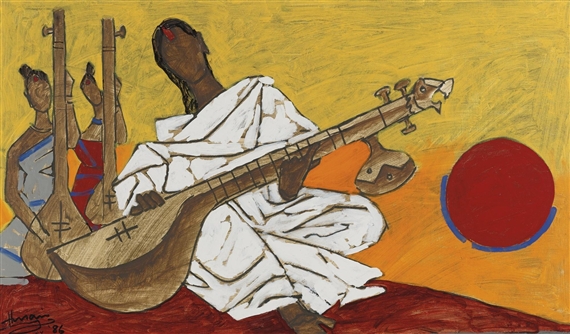On this page I am pulling together learning resources on Indian classical music. I will keep adding links as I find them. These selections are mainly intended for the learner and the curious. I would even say it is for someone who is not yet a student. Here is what I mean:
I love music, I enjoy it, I am immersed in it when I hear it, but if you ask me to explain what is melody, harmony or rhythm, I draw a blank. These words don’t spring any meanings for me. Does it mean I don’t have an ear for music? No. But I still would like to distinguish melody from harmony from rhythm in any song. But I cannot. So I think I am not even a student. I need preparation to be a student. This is what I mean by not yet a student.
If you have an online resource that fits the below pattern, please email it to me at: raagamorg@gmail.com and I will add to this list.
Page updated: 29 March 2020
Featured image: Untitled (Woman Playing Sitar), by M.F. Husain, WikiArt.org
Vox Guru YouTube
I like this online teaching channel very much. She takes the time to explain the underlying notions so well, using analogies from day-to-day life. See Vox Guru on YouTube.
Raga Unveiled Online
A stunning documentary, running at 4 hours and 20 minutes, on the origins of Hindustani classical music, produced by Gita Desai and her team at Raga Unveiled. Streaming and DVD. Anyone interested to learn about Indian classical music must watch this.
Demystifying Indian Classical Music
This site, Demystifying Indian Classical Music, is another good resource for the beginner.
North Indian Classical Music Online Program at Kadenze
An online program consisting of three courses. From the course website:
The North Indian Classical Music program aims to introduce this music tradition to any music motivated learner by combining theoretical and practical teaching approaches.
The first course covers the fundamental elements of North Indian Classical Music, from the Swara (note) and Laya (tempo) to the concepts of Raga (melodic framework) and Tala (rhythm framework).
The second course begins with a closer and more detailed look at the Raga, and also explains the language of the Tabla, and how this is used to aesthetically structure the Awartan of the Tala.
Lastly, the third course begins with explaining the structure of the two basic forms most prevalent today, the Khayal for Vocal performance, and the Alaap, Jod, Jhala and Gat for some instruments.
Students will receive feedback through a series of quizzes and by submitting practical performance assignments that are evaluated by assistant teachers with the support of the Music Critic technology.
This program is a collaboration between the Music Technology Group of the Universitat Pompeu Fabra of Barcelona, a research group that has been studying the music of India, and RagaSphere, a team of Indian professional musicians and educators dedicated to disseminate North Indian Classical Music.
Course site: https://www.kadenze.com/programs/north-indian-classical-music.
Ali Akbar College of Music Online Classes
Online courses: https://classes.aacm.org/courses.
There is a heart-breaking and inspiring interview with Ali Akbar Khan, where is says:
… because this kind of music is not for entertainment, it is for your soul, and so that, you can reach to God, you can feel it, and also, inside it is like a beautiful thing it creates that you never want to harm anyone.
Watch the 6-minute interview here: https://aliakbarkhanlibrary.com/videos/ali-akbar-khan-interview-reflections-on-his-father/.
More Ali Akbar Khan Library website: https://aacm.org/ali-akbar-college-of-music-library-of-classical-indian-music/.
Ragya
Streaming Indian classical music. Mobile and web apps. Subscription service. It is so good I have it on almost all the time I am at home. Web site: https://www.ragya.com/about.
Pandit Satyasheel Deshpande
A collection of writings, video talks, performances and audio files by Pandit Satyasheel Deshpande. All performances are learning sources, but there are a few videos and writings where he especially focuses on the art itself. Tremendously helpful if you understand Marathi, but even if you only understand Hindi these are a great resource. Those articles written in Marathi are crying out for translation into English. See here: Pt. Satyasheel Deshpande.
Also see the YouTube playlist of the videos by one Srijan Deshpande (thanks, Srijan): https://www.youtube.com/channel/UCOErqOsiFNW8h-c6gwPfufw.
